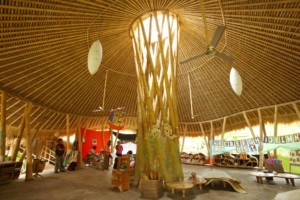Education Innovation: In US & Across the Globe

Innovations in learning are transforming education for children around the world, both in formal and informal learning environments. The #EIE15 conference highlighted a full spectrum of these environments and the policies in place to allow for the innovations to transform learning.
Choice is giving people what they want and need. Innovation is doing it cheaper and better. @ArthurBrooks #EIE15
— ExcelinEd (@ExcelinEd) October 23, 2015
Among the many great speakers at #EIE15 this week was education researcher Dr. Sugata Mitra. He is Professor of Educational Technology at the School of Education, Communication and Language Sciences at Newcastle University, UK. He is known as one of the pioneers of the self-organized learning environment (SOLE) movement (see his speech here).
As Dr. Mitra explained machines were created to replicate a process. Our schools were created much like this – a place to produce people that all think and know the same thing. Our current schools are not broken, they are just obsolete. They are still very much doing what they were created to do, but that’s not what we need for students any longer.
"Schools, as they exist today, are obsolete." (Designed for different needs of a different age.) – Dr. Sugata Mitra #EIE15 #uted
— Timothy Hawkes (@timothyhawkes) October 22, 2015
Much of Dr. Mitra’s research is based on the “Hole in the Wall” experiment where students were given free access to a computer in an Indian slum in Kalkaji, Delhi. 30 learning stations were set up in 2000 by the Government of Delhi.
Inspiring to hear @Sugatam speak about Hole in the Wall initiative #eie15 pic.twitter.com/z3VaRqNIED
— GS Services (@GSmartServices) October 22, 2015
After years of research Dr. Mitra determined “groups of children, with access to the Internet, can learn almost anything by themselves.” Dr. Mitra’s work building School in the Cloud earned him a $1 million TED prize.
As numerous EIE15 speakers highlighted, innovation in education is happening across the globe, but it’s also happening in classrooms across the U.S.
.@NextGenStacey connects @Sugatam global work on SOLEs to shifts in learning environments in classrooms across the U.S. #EIE15
— Carri Schneider, Ed.D. (@CarriSchneider) October 23, 2015
Moderated by Stacey Childress (NewSchools Venture Fund CEO), the How to Spark Education Innovation in Your State panel explored the differences between innovative education models, discussed the range of policies states can pursue to encourage innovation and explored policies and lessons learned from states with experience.
Following are insights on supporting education innovation in schools and districts from the panelists.
Dr. Lisa Duty (Partner, The Learning Accelerator) provided an overview of blended learning and explained how states can support its implementation.
#EdPolicy advice from @LisaDuty1: develop new models, innovate the way the system behaves, build the capacity of people/orgs #EIE15
— Carri Schneider, Ed.D. (@CarriSchneider) October 23, 2015
Marilyn Whitney (Senior Special Assistant for Education, Office of the Idaho Governor) highlighted the work and results of the Idaho Task Force for Improving Education – particularly the recommendation to shift to a mastery-based system.
Idaho Taskforce and follow-up HB110 highlighted as an example of moving from vision to reality in enabling mastery-based learning. #EIE15
— Carri Schneider, Ed.D. (@CarriSchneider) October 23, 2015
Rep. D. Craig Horn, (North Carolina, House of Representatives) shared a legislative perspective by describing the North Carolina Digital Learning Plan–developed with the Friday Institute for Educational Innovation at NC State University in collaboration with policymakers, education leaders, practitioners, business leaders and other partners from throughout the State. In keeping what we recommend in our work Digital Learning Now and The Learning Accelerator in the Blended Learning Implementation Guide, Rep. Horn fervently described that states and districts should start with goals for teaching and learning and end with device choices.
https://twitter.com/PAStudentsFirst/status/657612260639031297
Thomas Rooney, the Superintendent of Lindsay Unified School District shared his perspective as leading a district highly regarded as one of the country’s pioneer personalized, competency-based school districts. Rooney’s story reminded us that innovation isn’t just for high-wealth districts and private schools. In his words, Lindsay is one with “incredibly difficult circumstances” to overcome. Yet, “every learner met at their level, guaranteed success and ready to choose college and career.”
The customized #competencyed system in Lindsay, CA serves students that the trad'l system has failed #EIE15 pic.twitter.com/z7M4bBTex5
— Carri Schneider, Ed.D. (@CarriSchneider) October 23, 2015
The vision for a truly customized system shared in this Lindsay Unified video is one that is possible at scale.
Joel Klein and Tom Vander Ark discussed new school development and the lessons from NYC. MDRC found that new schools, “Substantially increase students’ enrollment and persistence in postsecondary education — a finding that holds true for students of a wide range of abilities entering colleges across the spectrum of selectivity.” Tom noted:
- New school development complements school improvement in an urban portfolio strategy. While NYC could support transported choice with subways, most cities need to consider location and busing for equitable access.
- NYC has an unusual number of intermediaries and charter management organizations capable of new school development. Other cities need an incubator of talent, tools, and schools like 4.0 Schools or Imaginarium in Denver.
- Leadership development was critical to new school development in NYC and is now key to developing next generation models (see Preparing Leaders For Deeper Learning).
As many sessions throughout #EIE15 emphasized with a focus on removing barriers and enabling education innovation, we can get there.
For more check out:
- Boosting College and Career Readiness through Course Access
- Rocky Mountain Blend: Great Teachers, Strong Culture
For more on the @ExcelinEd National Summit on Education Reform visit the #EIE15 hashtag on Twitter.
ExcelinEd is a Getting Smart Advocacy Partner.







0 Comments
Leave a Comment
Your email address will not be published. All fields are required.